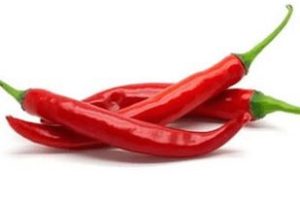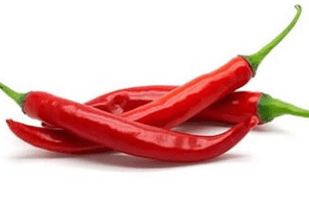Cayenne Pepper
Overview:
 Cayenne pepper (Capsicum annuum) is a small-fruited pepper from the nightshade family (Solanaceae) known for its intense spiciness.
Cayenne pepper (Capsicum annuum) is a small-fruited pepper from the nightshade family (Solanaceae) known for its intense spiciness. This variety of Capsicum annuum, believed to have originated in Cayenne, French Guiana, is used to produce a potent spice.
The spice is made by drying and grinding the orange to deep-red fruits, with its sharp flavor coming from the compound capsaicin.
The pepper plant is a perennial in tropical climates but often grown annually in temperate regions.
Cayenne pepper Scoville : The peppers typically range from 30,000 to 50,000 Scoville Heat Units (SHU).
This makes them quite spicy but not as extreme as some hotter varieties like habaneros or ghost peppers.
It typically grows about 2 to 3 feet tall and produces small, green, and red peppers. The plant prefers full sun and well-drained soil.
The pepper is a type of hot chili pepper often used in cooking and traditional medicine. The pepper adds heat and depth to dishes. It’s commonly used in cuisines around the world, including Mexican, Indian, and Thai dishes.
Nutritional Information (per 1 teaspoon of ground the pepper, approximately 2.3 grams):
- Calories: 6
- Protein: 0.3 grams
- Fat: 0.3 grams
- Carbohydrates: 1 gram
- Fiber: 0.6 grams
- Sugars: 0 grams
- Vitamins and Minerals:
- Vitamin A: 10% of the Daily Value (DV)
- Vitamin C: 2% of the DV
- Vitamin E: 2% of the DV
- Vitamin K: 2% of the DV
- Potassium: 2% of the DV
- Iron: 2% of the DV
- Manganese: 4% of the DV
Cayenne pepper benefits
Cayenne pepper, known for its fiery kick, also boasts a range of health benefits.
- Boosts Metabolism: The capsaicin in the pepper can increase metabolism, which may help with weight management by boosting the rate at which the body burns calories.
- Pain Relief: Capsaicin is also used in topical creams and patches for its analgesic properties. It can help reduce pain by depleting substance P, a neurotransmitter involved in transmitting pain signals.
- Digestive Health: The pepper can stimulate digestive enzymes and increase stomach acid production, which may aid in digestion and help with conditions like indigestion.
- Cardiovascular Health: The capsaicin in cayenne pepper may help improve heart health by reducing cholesterol levels, lowering blood pressure, and improving circulation.
- Anti-Inflammatory Effects: Capsaicin has anti-inflammatory properties that can help reduce inflammation and may be beneficial for conditions like arthritis.
- Immune System Support: Rich in vitamins A and C, cayenne pepper can help strengthen the immune system and support overall health.
- Detoxification: The pepper can promote sweating and improve circulation, which may aid in the body’s natural detoxification processes.
- Antioxidant Properties: It contains antioxidants that can help combat oxidative stress and reduce the risk of chronic diseases.
Cayenne pepper plants
The pepper plants are quite rewarding to grow! They’re part of the Capsicum annuum species and are known for their fiery heat and vibrant red peppers.
Here are some tips for pepper growing them successfully:
- Climate: The pepper thrive in warm climates. They need a lot of sunshine and a growing season of 60-90 days. If you’re in a cooler region, consider starting them indoors or using a greenhouse.
- Soil: They prefer well-draining soil rich in organic matter. Aim for a soil pH of 6.0 to 6.8.
- Planting: Start seeds indoors 8-10 weeks before the last frost. Transplant seedlings outside after all danger of frost has passed and when the soil temperature is consistently above 60°F (15°C).
- Watering: Keep the soil consistently moist but not waterlogged. Peppers generally prefer slightly drier conditions compared to some other plants.
- Fertilization: Use a balanced fertilizer or one higher in phosphorus to promote blooming and fruiting. Avoid too much nitrogen, as it can lead to lots of foliage but fewer peppers.
- Pruning: While not necessary, you can prune the plants to improve air circulation and encourage bushier growth.
- Pests and Diseases: Watch out for common pests like aphids and spider mites, and diseases such as powdery mildew. Regular inspection and proper spacing can help prevent these issues.
- Harvesting: Peppers are usually ready to harvest when they turn red, but you can pick them earlier if you prefer them less mature. Use scissors or pruners to cut them off the plant to avoid damaging the plant.
Cayenne pepper recipes
1. Cayenne Pepper Chicken Wings
Ingredients:
- 2 lbs chicken wings
- 2 tbsp olive oil
- 1 tbsp cayenne pepper
- 1 tsp paprika
- 1 tsp garlic powder
- 1 tsp onion powder
- Salt and pepper to taste
Instructions:
- Preheat your oven to 400°F (200°C).
- Toss the chicken wings in olive oil.
- Mix cayenne pepper, paprika, garlic powder, onion powder, salt, and pepper in a bowl.
- Coat the wings evenly with the spice mixture.
- Spread the wings on a baking sheet in a single layer.
- Bake for 35-40 minutes or until crispy and cooked through, flipping halfway through.
2. Spicy Cayenne Pepper Chili
Ingredients:
- 1 lb ground beef
- 1 onion, chopped
- 2 cloves garlic, minced
- 1 bell pepper, chopped
- 2 cans diced tomatoes (14.5 oz each)
- 1 can kidney beans, drained and rinsed
- 1 can black beans, drained and rinsed
- 1-2 tbsp cayenne pepper (adjust to taste)
- 1 tbsp chili powder
- 1 tsp cumin
- Salt and pepper to taste
Instructions:
- In a large pot, cook ground beef over medium heat until browned. Drain excess fat.
- Add onion, garlic, and bell pepper to the pot. Cook until softened.
- Stir in diced tomatoes, beans, cayenne pepper, chili powder, cumin, salt, and pepper.
- Simmer for 30-45 minutes, stirring occasionally, until flavors meld and chili thickens.
3. Cayenne Pepper Infused Oil
Ingredients:
- 1 cup olive oil
- 1 tbsp cayenne pepper
- 1 clove garlic, minced (optional)
Instructions:
- In a small saucepan, combine olive oil and cayenne pepper (and garlic, if using).
- Heat over low heat for 10-15 minutes, stirring occasionally.
- Allow to cool, then strain the oil through a fine-mesh strainer into a clean bottle or jar.
- Store in a cool, dark place. Use to add a spicy kick to dishes or as a flavorful drizzle.
4. Cayenne Pepper Smoothie
Ingredients:
- 1 banana
- 1 cup spinach
- 1 cup almond milk (or any milk of choice)
- 1 tbsp honey or maple syrup
- A pinch of cayenne pepper
Instructions:
- Combine banana, spinach, almond milk, and honey in a blender.
- Blend until smooth.
- Add a pinch of cayenne pepper and blend again.
- Serve immediately for a spicy, nutritious boost.
5. Spicy Cayenne Pepper Hummus
Ingredients:
- 1 can chickpeas, drained and rinsed
- 1/4 cup tahini
- 2 tbsp olive oil
- 2 tbsp lemon juice
- 2 cloves garlic
- 1-2 tsp cayenne pepper (adjust to taste)
- Salt to taste
Instructions:
- Combine chickpeas, tahini, olive oil, lemon juice, garlic, and cayenne pepper in a food processor.
- Blend until smooth, adding water as needed to reach desired consistency.
- Season with salt to taste.
- Serve with pita bread, veggies, or as a spread.
